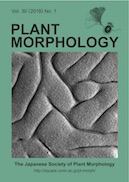Volume 30, Issue 1
Displaying 1-13 of 13 articles from this issue
- |<
- <
- 1
- >
- >|
Cover
-
2018Volume 30Issue 1 Pages 0
Published: 2018
Released on J-STAGE: April 01, 2019
Download PDF (1768K)
Invited Review
-
2018Volume 30Issue 1 Pages 1-2
Published: 2018
Released on J-STAGE: April 01, 2019
Download PDF (5609K) -
2018Volume 30Issue 1 Pages 3-4
Published: 2018
Released on J-STAGE: April 01, 2019
Download PDF (4689K) -
2018Volume 30Issue 1 Pages 5-14
Published: 2018
Released on J-STAGE: April 01, 2019
Download PDF (5946K) -
2018Volume 30Issue 1 Pages 15-24
Published: 2018
Released on J-STAGE: April 01, 2019
Download PDF (5746K) -
2018Volume 30Issue 1 Pages 25-29
Published: 2018
Released on J-STAGE: April 01, 2019
Download PDF (4940K) -
2018Volume 30Issue 1 Pages 31-36
Published: 2018
Released on J-STAGE: April 01, 2019
Download PDF (4907K) -
2018Volume 30Issue 1 Pages 37-58
Published: 2018
Released on J-STAGE: April 01, 2019
Download PDF (5244K) -
2018Volume 30Issue 1 Pages 59-64
Published: 2018
Released on J-STAGE: April 01, 2019
Download PDF (5374K)
Minireview
-
2018Volume 30Issue 1 Pages 65-72
Published: 2018
Released on J-STAGE: April 01, 2019
Download PDF (6262K) -
2018Volume 30Issue 1 Pages 73-81
Published: 2018
Released on J-STAGE: April 01, 2019
Download PDF (6359K) -
2018Volume 30Issue 1 Pages 83-89
Published: 2018
Released on J-STAGE: April 01, 2019
Download PDF (5647K)
Poster Abstract
-
2018Volume 30Issue 1 Pages 91-102
Published: 2018
Released on J-STAGE: April 01, 2019
Download PDF (4876K)
- |<
- <
- 1
- >
- >|
